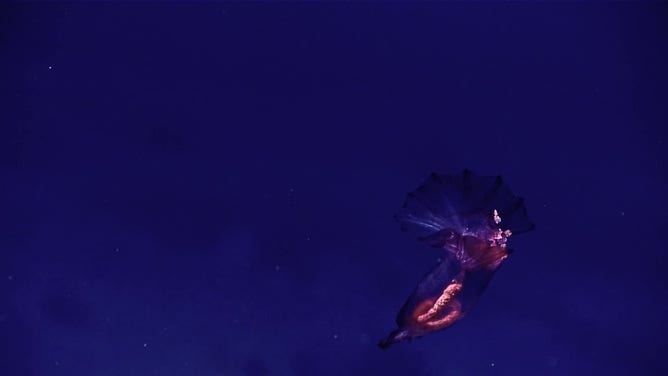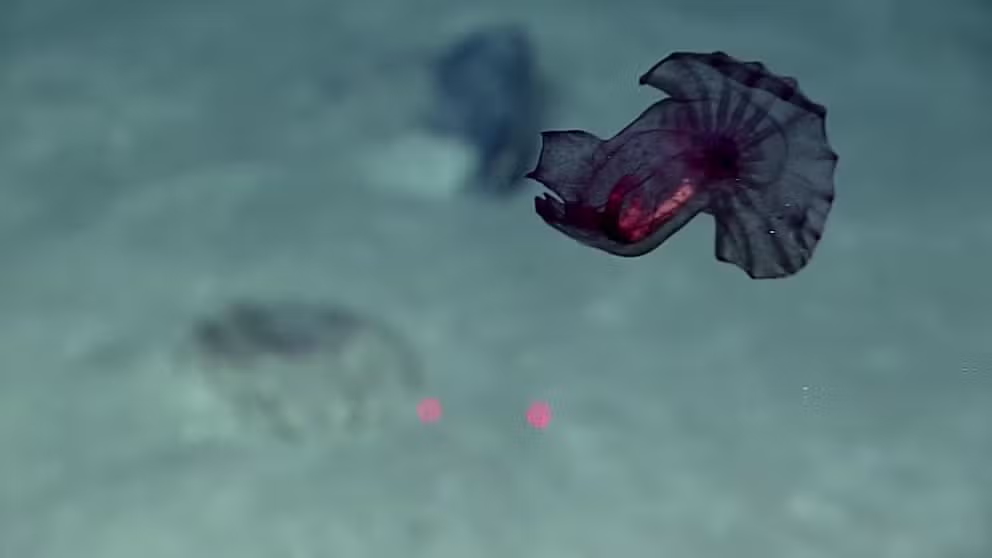Watch: Sea cucumber caught in rarely seen dance on underwater camera
Only the invention of deep-sea submersibles and ROVs enabled scientists to get a glimpse of the deep-sea sea cucumber in the past several decades.
Watch: Dance of the sea cucumber
Almost two miles down off the coast of Kodiak, Alaska, scientists came upon a sea cucumber that had to bust a move.
Maybe not yet ready for "So You Think You Can Dance," the deep sea cucumber doesn't have a classic dancer's body but doesn't let that stop it from busting a move.
NOAA's Ocean Explorer recently caught this sea cucumber (Holothurian) while exploring and mapping the sea floor with an ROV off Kodiak, Alaska.
"You may have heard of the ‘Dance of the Sugar Plum Fairy,’ but what about the Dance of the Sea Cucumber?" NOAA posted on social media. "We observed this sea cucumber slowly lift off the seafloor and launch into a mesmerizing ‘dance’ during an Okeanos Seascape Alaska dive off Kodiak. Sweet!"
Mysterious and odd sea cucumber
The reason for the dance is still a mystery.
"Why are they swimming, and what are the evolutionary benefits of such behaviors? In 1990, Miller and Pawson from the Smithsonian Institution shared several assumptions," wrote Joan Li for the Schmidt Ocean Institute. "The swimming behavior could be a result of avoiding predators and physical dangers, trying to find more food faster, or they might be absorbing nutrients dissolved in the water. Many more scientists are still trying to answer these questions."
NEVER-BEFORE-SEEN FISH FOUND MORE THAN 3 MILES UNDER THE SEA
NOAA's favorite sea cucumber dances
NOAA put together a few of their favorite deep-sea sea cucumber dances captured by a remote camera. One cuke is nicknamed the "headless chicken monster."
The several species that make up the deep-sea class of wildlife have some peculiar attributes, according to Joan Li writing for the Schmidt Ocean Institute.
- Some species shoot their guts (viscera), while others shoot sticky organs to escape predators. The cues then regenerate the missing organ.
- They sometimes let pearlfish live in their anus. And they breathe oxygen from water drawn through the anus.
- Some are transparent and translucent. When attacked, they can shed their skin and transfer bioluminescence onto the predator, making that animal more prone to attack from another predator. The sea cucumber then regrows the skin.
And several look quite strange. ROV pilots in the oil industry in the Gulf of Mexico call one species the "headless chicken monster," according to NOAA.

The "headless chicken monster."
(Ocean Explorer / NOAA)
The animals live below 656 feet deep in near darkness, to the seafloor. The water is only 39 degrees. Food is scarce on the seafloor. NOAA said that many call the sea cucumber the "vacuum cleaners of the sea."
"Sea cucumbers feed on nutrients attached to sediments on the seafloor. They use their tube feet to ‘eat’ seafloor mud, extracting what little nutrition may have persisted after slowly sinking from the productive upper ocean, and then expelling undigested mud," explained NOAA.
A rare sight
"And now we have the rare dance of the sea cucumber," NOAA scientist says on video accompanying a remote deep-sea camera mapping of the North Pacific Ocean.
SEE THE GHOSTLY ANIMAL THAT HAS SET THE RECORD FOR THE DEEPEST-LIVING FISH ON EARTH
Despite plentiful numbers of deep-sea cucumbers, seeing the dance is still rare, according to NOAA scientists. One reason is because the creatures are so difficult to see.
"The deep-sea holothurian community remains very mysterious. Deep-sea cucumber taxa have been documented since the 19th century, and samples are mainly collected by trawling blindly or as bycatch during fishing," explained Li. "Only with the technological advancement of submersibles in the past 20-30 years has it become possible for us to observe and record in-situ appearance and behavior of bathyal and abyssal holothurians."

